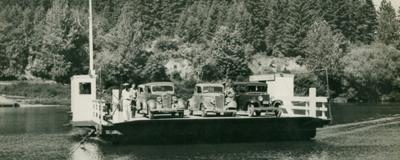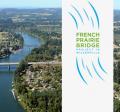French Prairie Bridge Project History & About
Filling a gap in regional transportation infrastructure
Currently, the only bridge crossing in a 30-mile stretch of the Willamette River in the south Portland metro area is the I-5 Boone Bridge. The shoulder of the Boone Bridge serves as the only accessible bridge crossing by foot or bike. This frequently congested bridge carries over 120,000 vehicles every day—nearly a third of which are large trucks—and provides cyclists and pedestrians with no separation from traffic.
In instances where there is an accident or other traffic disruption, back-ups on I-5 can impact emergency response time and secondary responders working to clear the road can have difficulty getting to the accident site.
Addressing local connectivity
The French Prairie Bridge Project is the result of community conversations and planning efforts that identified the need for a safe bicycle and pedestrian crossing of the Willamette River more than 20 years ago.
This safe bike/pedestrian crossing would improve connectivity to both planned bike/ped trails and existing roads. An interconnected bike/ped system would provide a seamless route connecting the Portland-area Intertwine Trail Network and Ice Age Tonquin Trail with the Willamette Valley Scenic Bikeway. It would also provide an alternative to I-5 for residents south of the river who commute to Wilsonville for work.
Project Goal:
Position the City of Wilsonville and regional partners to have the information they need to determine if the community would like to pursue final design and construction.
This includes identifying:
- Preferred bridge location and landing points
- Preferred bridge type
- Impacts and benefits (environmental, property, utility)
- Cost for final design and construction
History
Over the past 20 years, the Wilsonville community has worked to refine its vision for a new bicycle and pedestrian crossing over the Willamette River.
The proposed French Prairie Bridge would be in the approximate location of the historic Boones Ferry, which served as a critical link between the Willamette Valley and Portland region for more than a century.
The timeline below describes the history of this site as a crossing location and key moments in the community conversation about this project.
The Boones Ferry – 1847-1954
Founded by the grandson of famous explorer Daniel Boone, the Boones Ferry operated from 1847 to 1954. The ferry served as a primary access point for Willamette Valley farmers bringing their goods to market in Portland. Boones Ferry Road still extends from Woodburn to the south all the way to the edge of south Portland.
Over its time of service, the ferry provided access for modes of transport ranging from horse and buggy, to cars, to people on foot.
I-5 Boone Bridge – 1954-current
In 1954, the Oregon Department of Transportation built the Interstate 5 (I-5) Boone Bridge over the Willamette River. Shortly after the I-5 Boone Bridge opened, Boones Ferry was decommissioned.
For the past 60 plus years, the I-5 Boone Bridge has offered the only fixed crossing in a 30-mile stretch of the Willamette River in the south Portland metro region—serving as a primary freight route and offering access to cyclists and pedestrians on the shoulder of the freeway. The only other Willamette River bridges in the south metro region are the Hillsboro-Silverton Highway 219 Bridge near Newberg and the Highway 43 Bridge between West Linn and Oregon City (see map).
Identifying a need for improved bike and pedestrian access over the Willamette River – 1993
The Wilsonville community identified a need for safe bicycle and pedestrian access across the Willamette River in the 1993 Bike & Pedestrian Master Plan.
Prior planning efforts and conversations, including the 1991 Transportation Master Plan, identified the shoulders of the I-5 Boone Bridge as an existing bikeway and preferred route for cyclists and pedestrians. Subsequently, the northbound shoulder was reduced in width to four feet.
Refining the vision for a safe crossing – 1994-2016
The concept of improving bicycle and pedestrian access over the Willamette River was further refined in the City’s Bike & Pedestrian Master Plan (2006), Parks & Recreation Master Plan (1994, 2007), and Transportation System Plan (2003, 2013, 2016). The Bike and Pedestrian Master Plan evaluated several options for a pedestrian/bicycle crossing, including cantilevering a bridge from I-5, adding a bridge to the railroad crossing, and establishing a bicycle/pedestrian ferry. A standalone structure was identified as the best long-term option for the City.
Additionally, Metro’s regional Ice Age Tonquin Trail Master Plan (2013) identified this proposed crossing as a future connection over the Willamette River—bridging access between the cultural resources of the Willamette Valley with the planned 22-mile trail connecting Sherwood, Tualatin and Wilsonville.
From an economic development perspective, the Wilsonville Tourism Development Strategy (2014) identified improved bicycle and pedestrian infrastructure as a key element needed to attract bicycle tourism to the area.
- Bike Ped Master Plan 2006
- Parks & Rec Master Plan 2007
- Transportation System Plan 2016
- Ice Age Tonquin Trail
- Wilsonville Tourism Development Strategy 2014
Planning for the future: French Prairie Bridge Project Feasibility Study – 2014-2015
The City applied for federal funding to develop plans for the proposed bridge, and was awarded $1.25 million through Metro’s Transportation Improvement Program in 2009.
In preparation for the grant-funded planning and design project, the City conducted an initial feasibility study to determine whether potential bridge locations on the east side of the I-5 Boone Bridge, near Charbonneau, should be evaluated along with locations west of I-5. Due to significant challenges associated with potential east side bridge locations (including topography and property impacts), the City Council decided that the current project should focus on alternative locations between the I-5 Boone Bridge and the Portland and Western Railroad Bridge.
Download the Complete Materials
French Prairie Bridge Project in Wilsonville – 2016-2018
The French Prairie Bridge Project is developing preliminary designs for a new bike, pedestrian and emergency access crossing of the Willamette River.
The project aims to develop a solution that supports the community’s vision of having a safe, earthquake resilient crossing that promotes both economic and physical health.
The study area for potential bridge alignments is between the I-5 Boone Bridge and the existing Portland and Western Railroad Bridge over the Willamette River.





!["Boones Ferry" at landing in Wilsonville, Oregon. [1940] "Boones Ferry" at landing in Wilsonville, Oregon. [1940]](https://www.ci.wilsonville.or.us/sites/default/files/styles/full_node_primary/public/imageattachments/engineering/page/97248/french_prairie_bridge_riv01-1000x400.jpg?itok=IDX-A4Eb)
![Boones Ferry docked on north shore. [1909] Boones Ferry docked on north shore. [1909]](https://www.ci.wilsonville.or.us/sites/default/files/styles/full_node_primary/public/imageattachments/engineering/page/97248/french_prairie_bridge_riv06-1000x400.jpg?itok=WQFzS09W)
![Oregon Electric Railway trestle bridge from shoreline. [1909] Oregon Electric Railway trestle bridge from shoreline. [1909]](https://www.ci.wilsonville.or.us/sites/default/files/styles/full_node_primary/public/imageattachments/engineering/page/97248/french_prairie_bridge_riv08-1000x400.jpg?itok=bfVMPNxm)
![Ferry crosses the river. [1947 or 1948] Ferry crosses the river. [1947 or 1948]](https://www.ci.wilsonville.or.us/sites/default/files/styles/full_node_primary/public/imageattachments/engineering/page/97248/french_prairie_bridge_riv17-1000x400.jpg?itok=vU2K-ZM3)
!["Modoc" unloading at Wilsonville. [1906 or 1907] "Modoc" unloading at Wilsonville. [1906 or 1907]](https://www.ci.wilsonville.or.us/sites/default/files/styles/full_node_primary/public/imageattachments/engineering/page/97248/french_prairie_bridge_riv27-1000x400.jpg?itok=lS_z2_0k)
![Oregon Electric Railway bridge during construction. [1907] Oregon Electric Railway bridge during construction. [1907]](https://www.ci.wilsonville.or.us/sites/default/files/styles/full_node_primary/public/imageattachments/engineering/page/97248/french_prairie_bridge_riv29-1000x400_0.jpg?itok=Y6pYMgtJ)

![People and the trestle bridge. [1906-1907] People and the trestle bridge. [1906-1907]](https://www.ci.wilsonville.or.us/sites/default/files/styles/full_node_primary/public/imageattachments/engineering/page/97248/people_and_the_trestle_bridge_1906-1907.jpg?itok=V1RjKXv5)
